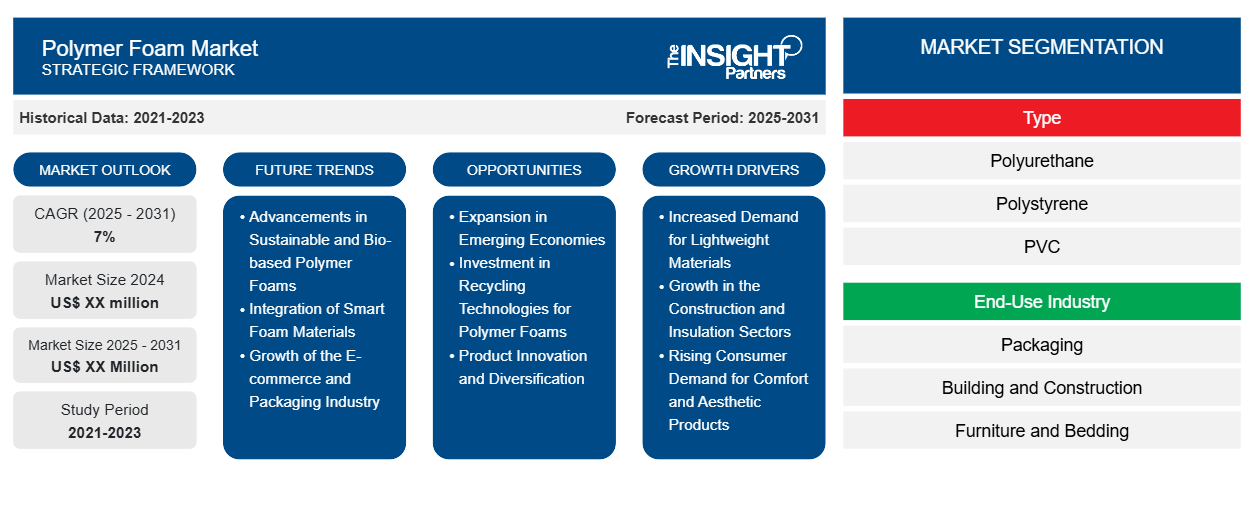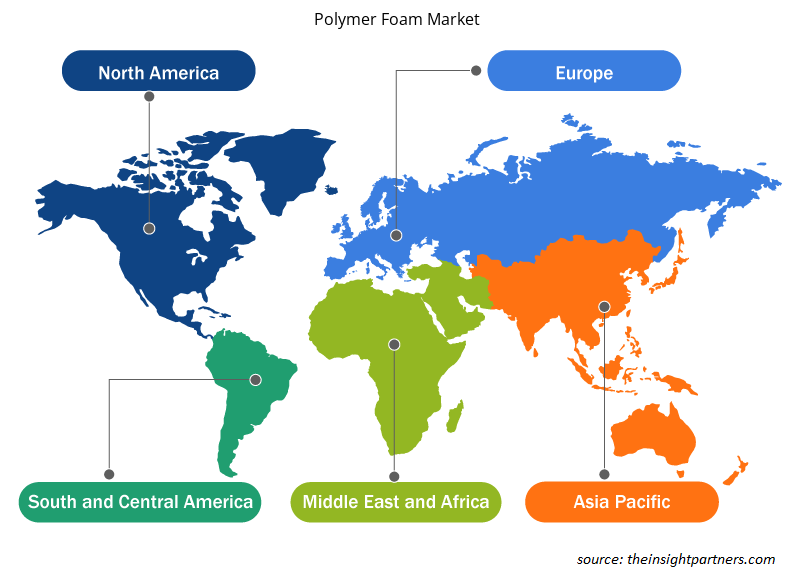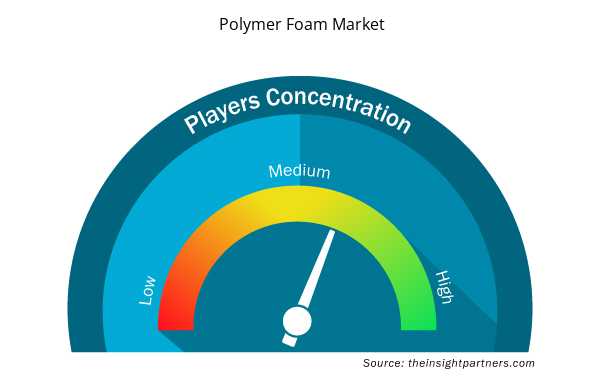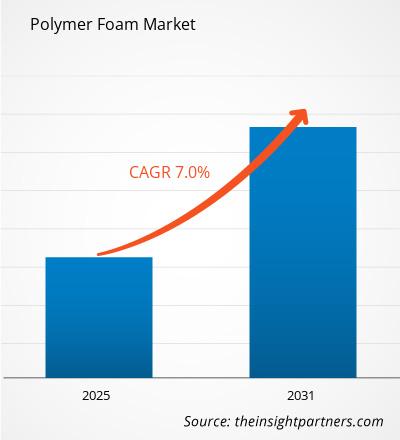The Polymer Foam Market is expected to register a CAGR of 7% from 2025 to 2031, with a market size expanding from US$ XX million in 2024 to US$ XX Million by 2031.
Polymer Foam Market covers analysis by Type (Polyurethane, Polystyrene, PVC, Phenolic, Polyolefin, Melamine, Others); End-Use Industry (Packaging, Building and Construction, Furniture and Bedding, Automotive, Footwear, Sports and Recreational, Others), and Geography (North America, Europe, Asia Pacific, Middle East and Africa, and South and Central America). Polymer foam is mainly produced by solid and gas phase mixed together to form a polymer foam. Various type of methods are used for producing polymer foam, which includes extrusion, slab-stock by pouring, and molding. The polymer foam is divided into two types, such as thermoplastics or thermosets. These are further classified into rigid foam and flexible foam.
Purpose of the Report
The report Polymer Foam Market by The Insight Partners aims to describe the present landscape and future growth, top driving factors, challenges, and opportunities. This will provide insights to various business stakeholders, such as:
- Technology Providers/Manufacturers: To understand the evolving market dynamics and know the potential growth opportunities, enabling them to make informed strategic decisions.
- Investors: To conduct a comprehensive trend analysis regarding the market growth rate, market financial projections, and opportunities that exist across the value chain.
- Regulatory bodies: To regulate policies and police activities in the market with the aim of minimizing abuse, preserving investor trust and confidence, and upholding the integrity and stability of the market.
Polymer Foam Market Segmentation
Type
- Polyurethane
- Polystyrene
- PVC
- Phenolic
- Polyolefin
- Melamine
End-Use Industry
- Packaging
- Building and Construction
- Furniture and Bedding
- Automotive
- Footwear
- Sports and Recreational
You will get customization on any report - free of charge - including parts of this report, or country-level analysis, Excel Data pack, as well as avail great offers and discounts for start-ups & universities
Polymer Foam Market: Strategic Insights

- Get Top Key Market Trends of this report.This FREE sample will include data analysis, ranging from market trends to estimates and forecasts.
Polymer Foam Market Growth Drivers
- Increased Demand for Lightweight Materials: A major driver of the global polymer foam market is the growing demand for lightweight materials across various industries, particularly in automotive, aerospace, and construction. Polymer foams, known for their low density and high strength-to-weight ratio, are used extensively to reduce the overall weight of products, thereby improving fuel efficiency and reducing carbon emissions. In the automotive industry, polymer foams are used in vehicle interiors, seats, bumpers, and insulation to reduce vehicle weight, which helps meet regulatory requirements for fuel efficiency and emissions. Similarly, in aerospace, polymer foams are used in aircraft components to achieve lighter structures. The increasing focus on energy efficiency and sustainability is driving the demand for lightweight materials, making polymer foams an essential part of modern manufacturing.
- Growth in the Construction and Insulation Sectors: The construction sector is a significant driver for the polymer foam market, particularly due to the growing demand for insulation materials. Polymer foams, such as expanded polystyrene (EPS) and polyurethane (PU), are widely used for thermal insulation in buildings, roofing, flooring, and walls due to their excellent insulating properties and low thermal conductivity. As global construction activity increases, especially in developing regions, and as building energy efficiency becomes more important due to stricter environmental regulations, the demand for polymer foams for insulation purposes continues to rise. Additionally, the growth in the construction of commercial and residential buildings, as well as infrastructural developments, will continue to fuel the market's expansion.
- Rising Consumer Demand for Comfort and Aesthetic Products: Another driver of the polymer foam market is the increasing consumer demand for comfort and aesthetic appeal in consumer goods, particularly in furniture, bedding, and packaging. In furniture, polymer foams, such as memory foam, are used for cushioning in mattresses, sofas, and chairs, providing comfort, support, and durability. Similarly, polymer foams are used in packaging materials to provide cushioning and protection for delicate products during transportation. As consumer preferences continue to favor comfortable, durable, and aesthetically pleasing products, the demand for polymer foam in these applications will continue to grow.
Polymer Foam Market Future Trends
- Advancements in Sustainable and Bio-based Polymer Foams: A key future trend in the polymer foam market is the increasing focus on sustainable and bio-based foams. As environmental concerns rise, industries are under pressure to reduce their reliance on petroleum-based materials and move toward more sustainable alternatives. Bio-based polymer foams, made from renewable resources such as plant-based oils, starches, and natural fibers, are gaining traction as environmentally friendly alternatives. These foams not only reduce carbon footprints but also offer biodegradability and recyclability, aligning with growing consumer preferences for eco-friendly products. The development of bio-based and sustainable polymer foams is expected to be a significant trend as companies seek to meet sustainability goals and regulatory requirements.
- Integration of Smart Foam Materials: The growing trend of integrating smart materials into polymer foams is set to impact the market in the coming years. Smart foams, which can adapt and respond to environmental stimuli (such as temperature, pressure, or humidity), are being developed for advanced applications. For example, foams with temperature-regulating properties are used in mattresses and pillows, offering enhanced comfort by adjusting to body temperature. Similarly, polymer foams embedded with sensors or actuators are finding use in the medical and automotive industries, such as in protective padding or airbag systems. The development of smart foam materials is expected to open up new applications and expand the potential of polymer foams beyond traditional uses.
- Growth of the E-commerce and Packaging Industry: The rapid growth of e-commerce is driving the demand for packaging solutions, including polymer foams, which provide cushioning and protection during product shipping. The increasing volume of online shopping, particularly in regions like North America and Asia-Pacific, has led to a significant rise in demand for packaging materials that ensure the safe transportation of goods. Polymer foams, including polyurethane (PU) and polyethylene (PE) foams, are used in protective packaging due to their lightweight, shock-absorbing, and insulating properties. As e-commerce continues to grow, especially for fragile or high-value products, the demand for polymer foams in packaging is expected to continue to rise.
Polymer Foam Market Opportunities
- Expansion in Emerging Economies: Emerging economies, particularly in Asia-Pacific, Latin America, and Africa, present significant growth opportunities for the global polymer foam market. These regions are experiencing rapid industrialization, urbanization, and infrastructure development, leading to an increased demand for polymer foams in construction, automotive, and consumer goods. In Asia-Pacific, for example, rising disposable incomes and an expanding middle class are driving demand for comfort products like mattresses and furniture, which utilize polymer foams. The growth of the construction industry in these regions also opens opportunities for the adoption of polymer foams in insulation and building materials. Companies can tap into these expanding markets by localizing production, forming strategic partnerships, and catering to the specific needs of these regions.
- Investment in Recycling Technologies for Polymer Foams: With increasing concerns over the environmental impact of waste materials, there is a growing opportunity for companies to invest in recycling technologies for polymer foams. Polymer foams, particularly those used in packaging, are often non-biodegradable and pose challenges for waste management. However, with advancements in recycling technologies, it is now possible to reuse and recycle polymer foams, turning them into new products and reducing waste. Companies that invest in developing or adopting efficient recycling processes can capitalize on the growing demand for sustainable and circular economy solutions, benefiting both the environment and their bottom line.
- Product Innovation and Diversification: Another significant opportunity in the polymer foam market lies in product innovation and diversification. Manufacturers can develop advanced polymer foams that offer specialized properties, such as improved fire resistance, enhanced strength, or advanced insulation performance. There is also a growing opportunity to diversify the range of applications of polymer foams, including in medical devices, aerospace components, and protective equipment. Innovations such as biodegradable foams, foams with antimicrobial properties, or foams with enhanced thermal insulation are in demand across various industries. Companies that focus on innovation and meet the evolving needs of end-users will be well-positioned for growth.
Polymer Foam Market Regional Insights
The regional trends and factors influencing the Polymer Foam Market throughout the forecast period have been thoroughly explained by the analysts at Insight Partners. This section also discusses Polymer Foam Market segments and geography across North America, Europe, Asia Pacific, Middle East and Africa, and South and Central America.

- Get the Regional Specific Data for Polymer Foam Market
Polymer Foam Market Report Scope
| Report Attribute | Details |
|---|---|
| Market size in 2024 | US$ XX million |
| Market Size by 2031 | US$ XX Million |
| Global CAGR (2025 - 2031) | 7% |
| Historical Data | 2021-2023 |
| Forecast period | 2025-2031 |
| Segments Covered |
By Type
|
| Regions and Countries Covered | North America
|
| Market leaders and key company profiles |
Polymer Foam Market Players Density: Understanding Its Impact on Business Dynamics
The Polymer Foam Market is growing rapidly, driven by increasing end-user demand due to factors such as evolving consumer preferences, technological advancements, and greater awareness of the product's benefits. As demand rises, businesses are expanding their offerings, innovating to meet consumer needs, and capitalizing on emerging trends, which further fuels market growth.
Market players density refers to the distribution of firms or companies operating within a particular market or industry. It indicates how many competitors (market players) are present in a given market space relative to its size or total market value.
Major Companies operating in the Polymer Foam Market are:
- Arkema
- Armacell International S.A
- BASF SE
- Borealis AG
- JSP
- Kaneka Corporation
Disclaimer: The companies listed above are not ranked in any particular order.

- Get the Polymer Foam Market top key players overview
Key Selling Points
- Comprehensive Coverage: The report comprehensively covers the analysis of products, services, types, and end users of the Polymer Foam Market, providing a holistic landscape.
- Expert Analysis: The report is compiled based on the in-depth understanding of industry experts and analysts.
- Up-to-date Information: The report assures business relevance due to its coverage of recent information and data trends.
- Customization Options: This report can be customized to cater to specific client requirements and suit the business strategies aptly.
The research report on the Polymer Foam Market can, therefore, help spearhead the trail of decoding and understanding the industry scenario and growth prospects. Although there can be a few valid concerns, the overall benefits of this report tend to outweigh the disadvantages.
- Historical Analysis (2 Years), Base Year, Forecast (7 Years) with CAGR
- PEST and SWOT Analysis
- Market Size Value / Volume - Global, Regional, Country
- Industry and Competitive Landscape
- Excel Dataset



Report Coverage
Revenue forecast, Company Analysis, Industry landscape, Growth factors, and Trends

Segment Covered
This text is related
to segments covered.

Regional Scope
North America, Europe, Asia Pacific, Middle East & Africa, South & Central America

Country Scope
This text is related
to country scope.
Frequently Asked Questions
Based on geography, which region is expected to record a highest CAGR in the market.
The North America market is expected to account for the highest CAGR during the forecast period owing to the growing automotive industry in the region.
What are the future trends in the market?
Growing demand for eco-friendly polymers is an emerging trend in the market.
Which end use industry segment accounted for the highest share in the polymer foam market?
The packaging end-use industry segment accounted for the largest market share in 2023.
What is the expected CAGR of the Polymer Foam Market ?
The Polymer Foam Market is estimated to witness a CAGR of 7% from 2023 to 2031
What are the driving factors impacting the polymer foam market?
Increasing demand from automotive industry is a key driver in the market
What are the key players operating in the polymer foam market?
Arkema, Armacell International S.A, BASF SE, Borealis AG, JSP, Kaneka Corporation, Sabic, Sealed Air, Toray Industries, Inc, and Total SA are some of the key players in the market.
Trends and growth analysis reports related to Chemicals and Materials : READ MORE..
1. Arkema
2. Armacell International S.A
3. BASF SE
4. Borealis AG
5. JSP
6. Kaneka Corporation
7. Sabic
8. Sealed Air
9. Toray Industries, Inc.
10. Total SA

 Get Free Sample For
Get Free Sample For